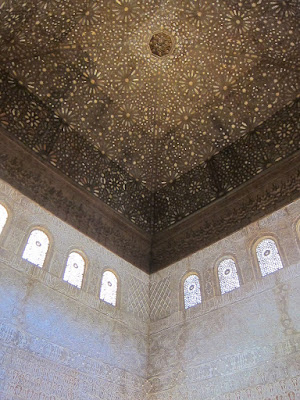The Moorish palaces were originally built in the 14th century by the Arab rulers of the Emirate of Granada so many of the architectural styles are Islamic and contain aspects such as Arabic writing. This first part of the complex you'll enter is the Mexuar, housing the business and administration wings for the Royal Palace.
Although the furnishings and architecture are a bit more modest than the rest of the palace, the columns and ceilings are still quite elaborately carved and decorated.
Some interesting wooden designs found on the walls, floors and ceilings.
These fountain designs are fairly common around the complex and give some of the rooms a very special character with the small circular pool of water situated in the center of the room.
Some very intricate patterns used in arches and doorways of the complex.
Among my favorite parts of the complex are these long pools of water of water surrounded by greenery. It gives off a very serene and pleasant feel. This one in particular is the stunning Court of the Myrtles, designed to help cool the complex and at the same time, reflect the power of the Sultan.
Arabic writing engraved in the walls of the palace:
Continuing on, we headed towards the Hall of the Ambassadors - I couldn't help but stop and admire the strangely unique designs in the arches and the honeycomb-like nature of this mini-grotto.
The stunning ceiling of the Hall of the Ambassadors is definitely not to be missed with its 75 ft high dome overlooking the grand reception room.
Again, if you're planning to see the Palaces at the Alhambra, be sure to book early in advance as you wont be able to get any tickets by the time you get there, especially if you're coming in from Seville three hours later. Next stop, the Nasrid Palace and gardens!
















No comments:
Post a Comment